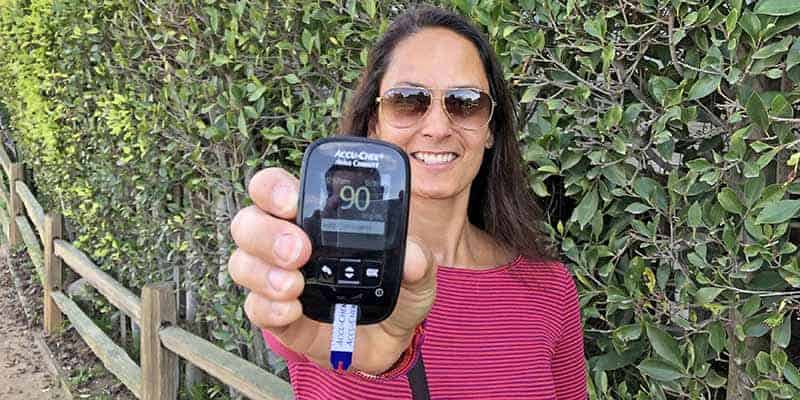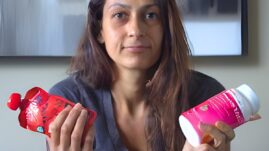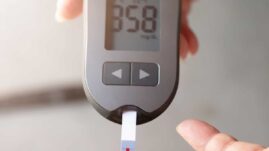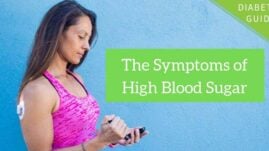Your blood glucose (sugar) levels are a critical part of your overall health and your body’s ability to function properly.
For those of us with diabetes, striving to achieve “normal” blood sugar levels is a constant, hour-by-hour pursuit. And it isn’t easy.
In this article, we’ll look at normal blood sugar levels and goal ranges for people without diabetes and recommended blood sugar goals for people with prediabetes, type 1 diabetes, and type 2 diabetes.

Table of Contents
- Normal blood sugar ranges in people without diabetes (chart)
- Recommended blood sugar ranges in people with diabetes (chart)
- How do you know what your blood glucose level is?
- Diagnosing prediabetes, type 1, and type 2 diabetes
- Your A1c and blood sugar goals
- Your blood sugar isn’t just because of what you eat
- Final thoughts: Still frustrated with your blood sugar and A1c results?
Normal blood sugar ranges in people without diabetes (chart)
For a person without any type of diabetes, blood sugar levels are generally between 70 to 99 mg/dL (3.9 to 5.5 mmol/L) fasting and under 140 mg/dL (7.8 mmol/L) after a meal.
Here are the normal blood sugar ranges for a person without diabetes according to the NIH:
| Fasting Blood Sugar (e.g., In the Morning Before Eating) | Less than 100 mg/dL (5.6 mmol/L) |
| 1 to 2 Hours After a Meal | Less than 140 mg/dL (7.8 mmol/L) |
| 2 to 3 Hours After a Meal | Less than 100 mg/dL (5.6 mmol/L) |
Recommended blood sugar ranges in people with diabetes (chart)
Here are the generally recommended blood sugar ranges for a person with diabetes according to the ADA:
| Fasting Blood Sugar (e.g., In the Morning Before Eating) | 80 to 130 mg/dL (4.4 to 7.2 mmol/L) |
| 1 to 2 Hours After a Meal | Less than 180 mg/dL (10.0 mmol/L) |
Learn more about fasting and after-meal blood sugar levels in: Blood Sugar Chart: Blood Sugar and A1c Targets.
How do you know what your blood glucose level is?
Unless it’s fairly high or low, you generally can’t feel what your blood sugar level is. And in fact, you may not even be able to tell from physical symptoms when it is high or low.
The best way to know your blood sugar level is to either check it with a traditional glucose meter or use a CGM (continuous glucose monitor) device.
For a glucose meter, you do a finger-stick with a lancet, put a drop of blood onto a test strip, and then insert the strip into the meter for a reading. With a CGM, readings are taken from the interstitial fluid (the fluid between the cells) about every 5 minutes via a sensor inserted just under the skin.
Diagnosing prediabetes, type 1, and type 2 diabetes
The following are tests that may be used by your healthcare provider to determine if you have diabetes:
Tests used to diagnose diabetes
Fasting plasma glucose test
This test measures your glucose level at a single point in time, typically after you have been fasting (nothing to eat or drink except water) for at least 8 hours.
Random glucose test
This test measures your glucose level at a single point in time and may be given at any time, whether you have fasted or not.
Oral glucose tolerance test (OGTT)
For this test, you will have a blood sample taken after fasting for at least 8 hours. Next, you will drink a liquid high in sugar and will have another blood sample taken after 2 hours to see how your blood glucose levels have changed.
(In those who are pregnant, glucose will be checked every hour for 2 to 3 hours to test for gestational diabetes.)
A1c test
This blood test reflects your average glucose levels over the previous 2 to 3 months. You can eat and drink prior to having an A1c test.
A repeat of these tests is typically required to confirm a diabetes diagnosis.
Test results for diagnosing diabetes (chart)
The following blood sugar and A1c results (a measure of glucose control over the previous 2 to 3 months) are used to diagnose prediabetes and diabetes, according to the ADA:
| A1c | Fasting Glucose | 2 Hours After a Meal | |
| Prediabetes | 5.7 to 6.4 percent | 100 to 125 mg/dL (5.6 to 6.9 mmol/L) | 140 mg/dL to 199 mg to dL (7.8 to 11.1 mmol/L) |
| Diabetes (type 1 or type 2) | 6.5 percent or higher | 126 mg/dL (7.0 mmol/L) or higher | 200 mg/dL (11.1 mmol/L) or higher |
Learn more about diagnosing diabetes in: Types of Diabetes.
Please note: Type 1 diabetes tends to develop very quickly, which means that by the time symptoms are felt, blood sugar levels are often well above 200 mg/dL all the time. For many people, symptoms come on so quickly that they are dismissed as a lingering flu or another seemingly ordinary virus.
By the time blood sugar levels are checked, many people with undiagnosed type 1 diabetes may have levels above 400 mg/dL or higher.
If you suspect that you or a loved one has type 1 diabetes, visit your primary care or urgent care immediately and ask for a urine test to measure ketones in addition to checking blood sugar levels and A1c.
Read more about ketones at diagnosis in: How to Avoid Diabetic Ketoacidosis (DKA).
Your A1c and blood sugar goals
Managing any type of diabetes is far more complicated than giving a person some insulin and telling them to keep their blood sugars within X and X mg/dL. If you’ve lived with diabetes for more than a few days, you probably already know this.
What is A1c?
“A1c, also known as hemoglobin A1c, HbA1c, glycated hemoglobin, or glycohemoglobin, is a blood test that measures your average blood sugar over the last 2 to 3 months,” explains Christel Oerum, MS, in Diabetes Strong’s guide to lowering your A1c.
Although the test reflects the glucose attached to hemoglobin (the protein in your red blood cells) over the past 2 to 3 months, the blood sugar levels in the 2 weeks leading up to your A1c test influence the results the most. Essentially, higher blood sugar levels during this period result in more glucose binding to hemoglobin.
Translating your A1c to a blood sugar level
Using this simple calculator from the ADA, you can translate your most recent A1c result to an “eAG,” or “estimated average glucose level.”
You can also use this translation when working to improve your A1c and achieve closer to normal blood sugar levels.
For instance, if you know an A1c of 6.0 percent equates to an average blood sugar level of 126 mg/dL (7.0 mmol/L), then you can look at your current blood sugar results on your CGM and meter and pinpoint what time of day you’re frequently higher than that level.
| A1c | eAG |
| 6 percent | 126 mg/dL |
| 7 percent | 154 mg/dL |
| 8 percent | 183 mg/dL |
| 9 percent | 212 mg/dL |
| 10 percent | 240 mg/dL |
| 11 percent | 269 mg/dL |
| 12 percent | 298 mg/dL |
Normal blood sugar levels in a person without diabetes can result in an A1c of 5.6 percent or lower.
Just a decade or two ago, it was rare for a person with type 1 diabetes to achieve an A1c result below 6.0 percent.
Thanks to new and improved insulin and better technology like CGMs, smarter insulin pumps, and hybrid closed-loop technology (which allows some insulin doses to be automatically delivered), more people with diabetes are now able to safely achieve A1c levels in the higher 5 percent range.
Why your A1c matters
In a nutshell: Your A1c is one of the clearest indicators of your risk for developing diabetes complications like neuropathy (nerve damage), retinopathy (a type of eye disease), nephropathy (kidney disease), cardiovascular disease, and severe infection in any part of your body that requires healing.
For instance, a small cut on your toe could become infected due to high blood sugars, struggle to heal, and become severe enough that the infection could require an amputation.
The general guidelines from the ADA recommend an A1c level of less than 7.0 percent to help prevent diabetes-related complications. Lowering your A1c closer to 6.0 percent may further reduce the risk of microvascular complications (those impacting the small blood vessels), such as those affecting the eyes (retinopathy), kidneys (nephropathy), and nerves (neuropathy).
Some people with diabetes aim for A1c levels in the 5s and lower — especially those who follow strict low-carb diets like the ketogenic diet and the Bernstein diet. However, this hasn’t been proven in research as especially necessary, nor is it reasonably achievable for the larger population of people with diabetes.
It’s also important to remember that your blood sugar levels and your A1c are just information that tells you whether your body needs changes in factors like insulin, other diabetes medications like metformin, your nutrition, or your physical activity.
If you don’t like the number you’re seeing on your glucose meter or your A1c results, use that number as motivation to make changes (with the support of your diabetes healthcare team) in how you safely manage your diabetes in order to get different results.
Determining the right A1c goal for you
Just because a blood sugar range of 70 to 130 mg/dL (3.9 to 7.2 mmol/L) is considered the healthiest for people with diabetes doesn’t necessarily mean that’s the appropriate goal range for you — especially if you have type 1 diabetes, or take insulin as a person with type 2 diabetes.
The reason this may not be the right goal for you is that extremely tight blood sugar management in people taking insulin can potentially lead to frequent hypoglycemia (low blood sugar), which can be dangerous.
Achieving extremely tight blood sugar management also generally requires a strict nutrition plan, very frequent blood sugar monitoring, precise medication management, and, often, years of experience studying your blood sugar levels.
Your A1c goals should be set in close consultation with your medical team, who can help balance the benefits and risks of different targets based on your health status, lifestyle, and preferences.
Older adults with cognitive or functional limitations or severe comorbidities (major additional health issues) may have a less-stringent A1c goal of less than 8 percent.
It is also worth noting that your A1c targets can change over time as your diabetes management evolves.
A1c goals should be individualized
“A1c goals should be individualized based on the individual capabilities, risks, and prior experiences,” explains Gary Scheiner, MS, CDCES, founder of Integrated Diabetes and author of Think Like a Pancreas.
“For example, we generally aim for very tight A1c levels during pregnancy and more conservative targets in young children and the elderly.”
Scheiner highlights important factors that could justify aiming for a higher A1c, like hypoglycemia unawareness, a condition in which a person with diabetes no longer feels the typical warning signs of low blood sugar.
Hypoglycemia unawareness can put you at significant risk for severe low blood sugars that have the potential to be life-threatening. To reduce that risk, you would aim for higher target blood sugar ranges.
“Someone with significant hypoglycemia unawareness and a history of severe lows should target higher blood glucose levels than someone who can detect and manage their lows more effectively,” adds Scheiner.
“And certainly, someone who has been running A1cs in double digits [like 10 percent or higher] for quite some time should not be targeting an A1c of 6 percent … better to set modest, realistic, achievable goals.”
Read about reducing your A1c in: How to Lower Your A1c and How to Lower A1c Naturally.
Your blood sugar isn’t just because of what you eat
It’s easy to believe that your blood sugar levels are impacted only by what you eat and how much you exercise, but people with type 1 and type 2 diabetes who check their blood sugars frequently could tell you otherwise.
It’s especially important to keep this in mind when looking at your own blood sugars and your goals, because there are certain variables and challenges that impact blood sugar levels that you can’t always control.
For example:
- Menstrual cycles: often raise blood sugar and insulin needs
- Adrenaline rushes from competitive sports, heated arguments, roller coaster rides, and other intense situations: raise blood sugar and insulin needs
- The common cold and other illnesses: usually raise blood sugar and insulin needs
- Hormonal changes due to puberty and healthy growth in young adults: raise blood sugar and insulin needs
- An injury that increases overall inflammation levels: raises blood sugar and insulin needs
- Gluconeogenesis during anaerobic exercise: raises blood sugar and insulin needs
While you can’t necessarily prevent these factors that affect your blood sugar from occurring, you can work with your diabetes healthcare team to adjust your insulin, other diabetes medications, nutrition, and activity levels to help compensate for them when they do occur.
For example, when engaging in anaerobic exercise such as weightlifting, many people with type 1 diabetes find it necessary to take a small bolus of insulin prior to or during their workout because anaerobic exercise can actually raise blood sugar.
Final thoughts: Still frustrated with your blood sugar and A1c results?
Your blood sugars and your insulin or medication needs never stay in one place. If you gain weight or lose weight, your insulin and medication needs will change. If you become more active or less active, your needs will change. If you make drastic or even small changes to your nutrition, your needs will change.
Working with your diabetes healthcare team and diabetes coaches who can teach you how to make changes in your overall diabetes management plan is essential. Diabetes is a lifelong learning process.
Take a deep breath and be patient. If you don’t like what you’re seeing on your glucose meter, don’t get mad … get studying! Take good notes and work with your team to make changes to reach your goals.





Tom G
Hi.Recently diagnosed type 2. Probably diabetic for well over 10 years. Unknown to me as I was without insurance for many years. My blood sugar level was 505 and my A1C was 14.9% when diagnosed in Mid-March 2022. My Dr. put me on Metformin 2x daily, morning and evening. I made strict changes to my diet and used the medication as prescribed. I had to have eye surgery in June to remove some cataracts that had developed in both eyes likely due to uncontrolled diabetes for many years as I am fairly young” just turned 58. So they tested my AIC again in early June prior to surgery. It came down to 8.2%. I had another A1C test the other day for my annual physical and it came down to 6.1%. However my morning fasting #’s have recently crept up into the low 200’s. My Dr said I might have Dawn Phenomenon. So she increased my nighttime dose of Metformin to 850 and wants me to take it at dinner instead of bedtime. This doesn’t make any sense to me because my evening numbers even after meals are never over 110. So why have me take a higher dose 4 hours earlier. ? Metformin only lasts about 7 hours. Thanks.
Christel Oerum
First of all, congrats on all your positive progress! That’s great.
I don’t know your doctor’s exact reason for advising you to take your Metformin earlier. It might be that she’s concerned that the larger dose will give you gastrointestinal issues, which can be mitigated by taking it with a meal.
Metformin does work longer than 7 hours and doesn’t instantly reduce blood sugar levels. The effects are usually noticeable within 48 hours. But I would just ask her. I always encourage anyone to discuss their medication with their medical team and push back if you disagree. They are the experts but you’re supposed to be a team, and it’s always ok to ask questions
Raj
Hi I am diabetic since 2 years now, but i could manage the ranges properly between 5.8 – 6.1 (H1BAC) but since 6 months my ranges are going over 6.9 and there was no much difference in my lifestyle (low carb intake + min 7000 steps walk ) i am trying hard to bring the ranges to normal but post meal ranges are most of the time between 130- 160 but my morning ranges are bit higher and are always between 120-140 can you please advice what can i do to bring these ranges to normal like before (Before 6 months always i manage to fall between 103- 118 but not anymore :()
Christel Oerum
I’d recommend you see your doctor and together make a plan for how to manage your blood sugars. You might have reached a point where diet and exercise no longer are enough to manage your blood sugars (read more here: https://diabetesstrong.com/is-type-2-diabetes-reversible/).
But aside from that, you could try adding resistance training to your routine, that is a great way of increasing your insulin sensitivity
Darara
Sadly am with type 2 diabetes just a year age I figured out when I was testing for my CDL medical test before, I never had any health problems ,never ever admitted hospital or any other place except for testing medical But truck driving damage my life. I can’t manage it’s some times 128 ,132,145, 231
I see all above Post are very helpful.
Thanks
Vivian
Hi! My physician didn’t diagnose my type 2 diabetes for 8 months, calling it depression and anxiety. I gained 80 pounds, and when I quit to another physician, my a1c was 11.2. My first physician actually made a referral to a psychiatrist for somatoform disorder. I bought a glucometer, my sugars were averaging 450. Then my first physician is all hyper wanting to be proactive. The second physician has proven much better. Sugars are now 80-125.
JIMMY LEWIS
I have been diagnosed as pre diabetic. Type 2. By watching my diet, which includes lowering my sugar consumption, I usually get a fasting reading of 99 to 120. Is this good, or does it need to stay around 99 or lower?
Christel Oerum
The ranges listed in this article are the general guidelines, however, diabetes management is often tailored to the individual. Your doctor might find 99-120 mg/dl to be an acceptable range but I encourage you to have that conversation with your doctor. If you both find that your levels should be lower you might have to alter your eating patterns further, include more exercise, or start a blood sugar-regulating drugs such as for example Metformin
Umar
Hi, is blood sugar of 103 after meal normal for a 24-year-old overall healthy male?
Christel Oerum
If you scroll down past the first paragraph you’ll see the normal blood sugar ranges for healthy non-diabetics. 103 mg/dl falls within that range
UMAR
Thank you!
Tina
Hi
I had undiagnosed type 2 diabetes in March of 2021. I was hospitalized with a blood sugar level of 1500.
My A1C is now 5% and my blood sugar runs 90-120. I achieved this by diet and exercise. You can too. Keep the faith.
Satya Bhaskar
I have been on medication since 2018 using Janumet 50/500 after breakfast n Glycomet SR 500 after dinner. In 2018 Hba1c is 7 2 n now it reads 5.9. Can I skip Janumet n take Glycomet SR after breakfast also.
Christel Oerum
Congrats on managing your blood sugars that well! You have to have that discussion with your medical team. Never change or discontinue your medication without consulting with your doctor
yo jo zethio
My last question is have I been taking antidepressants for the last 10 months and will this medication increase the effectiveness of HA1C result?
Christel Oerum
I don’t know the answer to that but I doubt it. It would be a good conversation to have with your doctor
Marianna
Can you tell me why when I get up my number is 118, but after I take shower, brush teeth etc, (about 1 hour) it jumps to 160, and I did not eat anything. It is very fustrating and I dont understand how this can be.
Christel Oerum
That sounds like a “Feet on the Floor” increase. It’s fairly common, so much that we have a whole article on how to avoid those high morning blood sugars that you can find here: https://diabetesstrong.com/how-to-avoid-high-morning-blood-sugars/
Rahul Lonchey
My fasting sugar count is 96 but my hb1ac is 6.2 kindly explain this
Christel Oerum
Your A1C is a reflection of your average blood sugars for the last 3 months. So your blood sugars must be running higher at other times of the day
yohanes
its My question is this is the same question as FBS 93, HAIC 6.2. Another question I have is whether drinking water on an empty stomach has any effect on the outcome.?
Christel Oerum
Hydration can impact blood sugars but you don’t have to drink water on an empty stomach